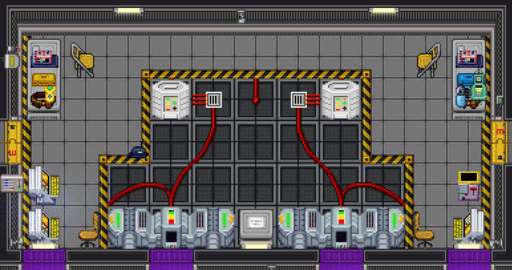Catalytic Generator
| This page is under construction. The following information may be incomplete. Page in construction for new Nadir content |
The catalytic generators are the main source of power for Nadir. They generate power by exposing cathode and anode rods to the acid sea, forming ions which can be used to generate electrical power. However, the rods degrade over time and will need to be periodically replaced to maintain power output. The anode rod goes in the left side of the engine, and the cathode rod goes in the right side. There are four engines, two in the northernmost and southernmost areas of the station.
Making Rods
Rods can be manufactured at a refining nano-fabricator, which can be found in the refinery or in engineering. They require one unit of a material, and the material must be metallic. The material properties of the rod determine its effectiveness as a cathode or an anode. Furthermore, the material's chemical resistance determines how rapidly it degrades over time.
Simple Output Math
The output of a catalytic engine is the lesser of the output power of the cathode and anode rods. The output power of a rod is determined by its condition (a number between 0 and 100 representing how corroded it is) multiplied by its efficacy (a positive number that represents how effective the materials are) multiplied by ten.
Cathode Efficacy
The efficacy of the cathode rod is determined by its hardness and density. Optimally, the cathode has 5 density and 5 hardness. The efficacy formula places more importance on density than hardness, as detailed in the tables below:
| 1 | 2 | 3 | 4 | 5 | 6 | 7 | 8 | 9 | |
| 1 | 0 | 0 | 0 | 0 | 0 | 0 | 0 | 0 | 0 |
| 2 | 23 | 29 | 34 | 40 | 45 | 40 | 34 | 29 | 23 |
| 3 | 47 | 58 | 68 | 79 | 90 | 79 | 68 | 58 | 47 |
| 4 | 70 | 86 | 111 | 199 | 332 | 199 | 111 | 86 | 70 |
| 5 | 94 | 176 | 350 | 630 | 1050 | 630 | 350 | 176 | 94 |
| 6 | 70 | 86 | 111 | 199 | 332 | 199 | 111 | 86 | 70 |
| 7 | 47 | 58 | 68 | 79 | 90 | 79 | 68 | 58 | 47 |
| 8 | 23 | 29 | 34 | 40 | 45 | 40 | 34 | 29 | 23 |
| 9 | 0 | 0 | 0 | 0 | 0 | 0 | 0 | 0 | 0 |
| Material | Density | Hardness | Cathode Efficacy | Chemical Resistance |
|---|---|---|---|---|
| Plasmasteel + Plasmaglass | 5 | 5 | 1055 | 5 |
| Bohrum | 6 | 5 | 332 | 7 |
| Mauxite | 4 | 3 | 111 | 5 |
| Steel | 4 | 3 | 111 | 5 |
Anode
The efficacy of the anode rod is determined by its electrical conductivity and whether it is an energy source or not. Optimally, the anode has 9 electrical and is an energy source. The details are listed in the tables below:
| Electrical | Normal | Energy Source |
|---|---|---|
| 1 | 17 | 22 |
| 2 | 34 | 44 |
| 3 | 51 | 66 |
| 4 | 68 | 88 |
| 5 | 85 | 149 |
| 6 | 108 | 309 |
| 7 | 201 | 573 |
| 8 | 342 | 977 |
| 9 | 548 | 1565 |
| Material | Electrical | Energy Source? | Anode Efficacy | Chemical Resistance |
|---|---|---|---|---|
| Electrum + Cerenkite + Electrum |
8 | Yes | 977 | 6 |
| Electrum + Cerenkite |
7 | Yes | 573 | 6 |
| Claretine + Cerenkite |
7 | Yes | 573 | 5 |
| Electrum | 9 | No | 548 | 6 |
| Cerenkite | 6 | Yes | 309 | 6 |
| Pharosium + Cerenkite |
6 | Yes | 309 | 6 |
| Pharosium | 7 | No | 201 | 6 |
| Claretine + Pharosium |
7 | No | 201 | 5 |
| Copper | 6 | No | 108 | 6 |
Due to not being a metal, pure claretine is not useable as an anode rod. Fractional stats of alloys are rounded down, meaning that some combinations that might intuitively improve the rod efficacy actually do not. It is currently impossible to make a material that has 9 electrical and is an energy source.

